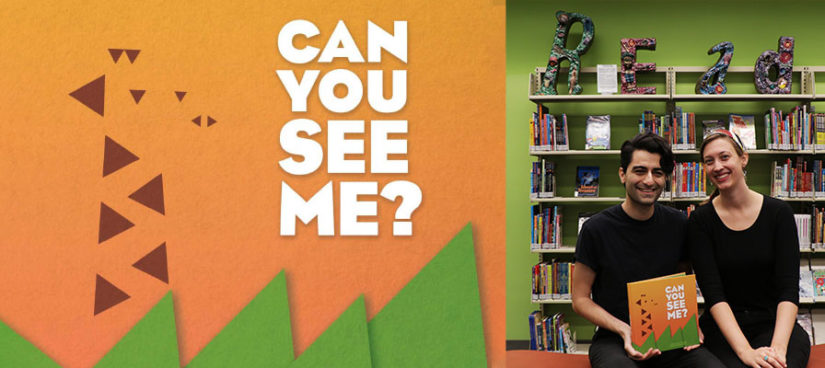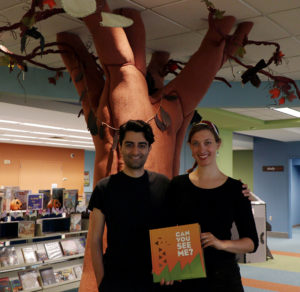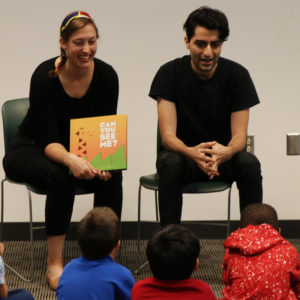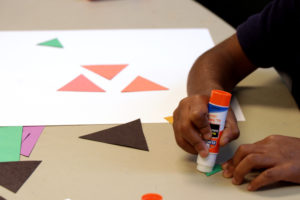
Sharing new perspectives
Many interactive picture books encourage families to work together, but Can You See Me?, a new interactive children’s book, invites kids and adults to celebrate their unique ways of seeing the world. This special project, the first of its kind in Andrews McMeel Publishing’s line of best-selling children’s books, employs abstract art by illustrating animals made up entirely of equilateral triangles. The creative minds behind the collaboration are Mikhala Lantz-Simmons and Mohammad Rasoulipour, a married couple who met while studying peacebuilding in the Shenandoah Valley and now live here in Kansas City, Missouri.
Mikhala and Mohammad were excited to talk to AMP about the story behind their new book.
To kick things off, where did you find the inspiration for Can You See Me?

Mohammad: As a designer, I’m always looking for clear ways to quickly communicate a message. This whole book started with a little thought project I had: How many equilateral triangles do you need to make a recognizable image of an animal? As it turns out, for some animals, not that many! With some slight shifts, the three triangles it takes to show a lamb can be changed into a fox. I started testing out the images by showing them to our friends’ kids. I quickly noticed that young people could see the animals faster than adults. And they even attributed emotions to the animals! So with the feedback of family and friends, I made a little “triangle zoo,” then published it on Behance.
Mikhala: Mo (Mohammad) is always working on projects like this. One day I’ll come home and he’s illustrating all of the BMWs ever made. The next, he’s creating the visual identity for a made-up university. I was initially less sure about this triangle project. He would test the animals out on me, and sometimes I’d feel frustrated because I couldn’t see what he had in mind. Is that an alligator head or a millipede? But when it would click and I’d see that the lion had her head turned to the side, it felt satisfying. I saw other people (younger and older) experiencing the same gratification, and I thought to myself that this could be a book.
What did the collaboration process look like?
Mohammad: Mikhala convinced me that we should have words. At first, I wanted the images to speak for themselves. But after she wrote a couple of examples, I saw that the clues really added something. As she began writing the text, I started creating backgrounds (triangles only) to show off the animals’ habitats.
Mikhala: I had a lot of fun working on the text. Sometimes children’s books can be tedious to read. I wanted something snappy, with a fun-to-repeat phrase. I also wanted a soothing ending. That’s why the book ends with the cat, curling up in your lap — a “wink, wink, nod, nod” that it is time to go to sleep! So I wrote several possible rhymes for the animals, including some animals who didn’t make it into the book. Then Mohammad and I would read them out loud to see which ones caught. I’d be biking to the university and repeating the words out loud. That was the sign that the text in question would stay.
You’ve both worn a variety of hats in your current and former jobs. How have those experiences shaped this most recent role as children’s book creators?

Mikhala: I’ve worked in education and in youth programming. That contributes to my firm beliefs in trusting young people and their creativity. Take our lack of a solutions page [in the book], for example. If someone sees a different animal than we intended, good! Learning is about being curious and being open to other ways of seeing the world.
Part of Can You See Me?‘s appeal is the surprise of finding animals where you might not expect them at first. Have there been any surprising moments while reading the book with kids? Do they sometimes see other animals than the ones you originally intended?
Mohammad: We’ve got a video of our young friend Parsa (he’s mentioned on the dedication page) reading through the book for the first time. He literally sang his way through it, with his eyes lighting up each time he figured out the animal. I was so delighted when on the alligator page, he gleefully said, “A DINOSAUR!”
Mikhala: … And actually, he’s totally right!
Andrews McMeel represents authors from all over the world, but it’s not every day we get to work with creators in our hometown of Kansas City. To celebrate the launch of Can You See Me?, you both hosted a special story time event with the Kansas City Public Library. What was your experience like interacting with local kids and helping them create their own designs out of triangles?

Mohammad: During the reading, the students’ reactions were priceless. It confirmed for me that children are often more bravely imaginative than us adults. What I had imagined as an owl was interpreted during story time as a three-toed sloth. Another student saw a skateboard where I’d seen a seal. It was neat seeing the young people being validated by their peers and the adults in the room for stretching their imagination.
Mikhala: The follow-up activity that the library organized was exactly the type of interaction we hoped this book would generate. The students got to take triangles and make their own images that ranged from robots to teddy bears. For the two of us, this reading was absolutely one of the high points of our year!
Thanks, Mikhala and Mohammad!
Can You See Me? is available now, wherever books are sold.
